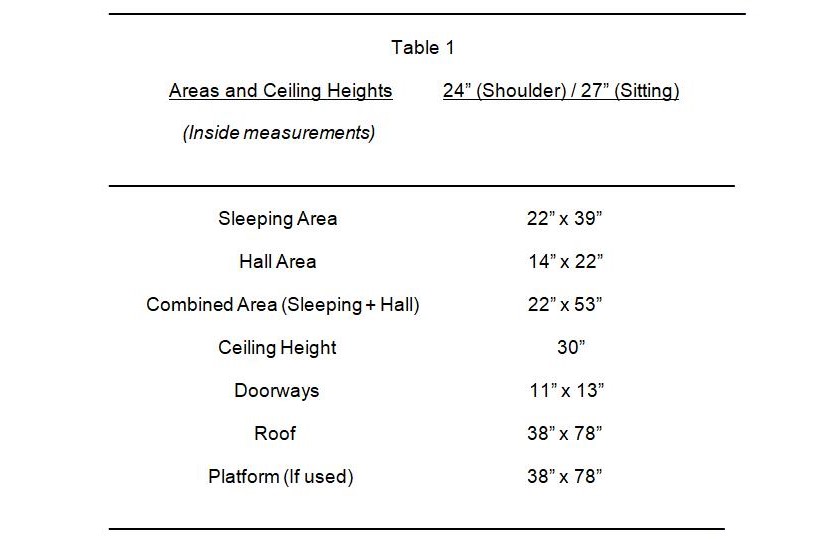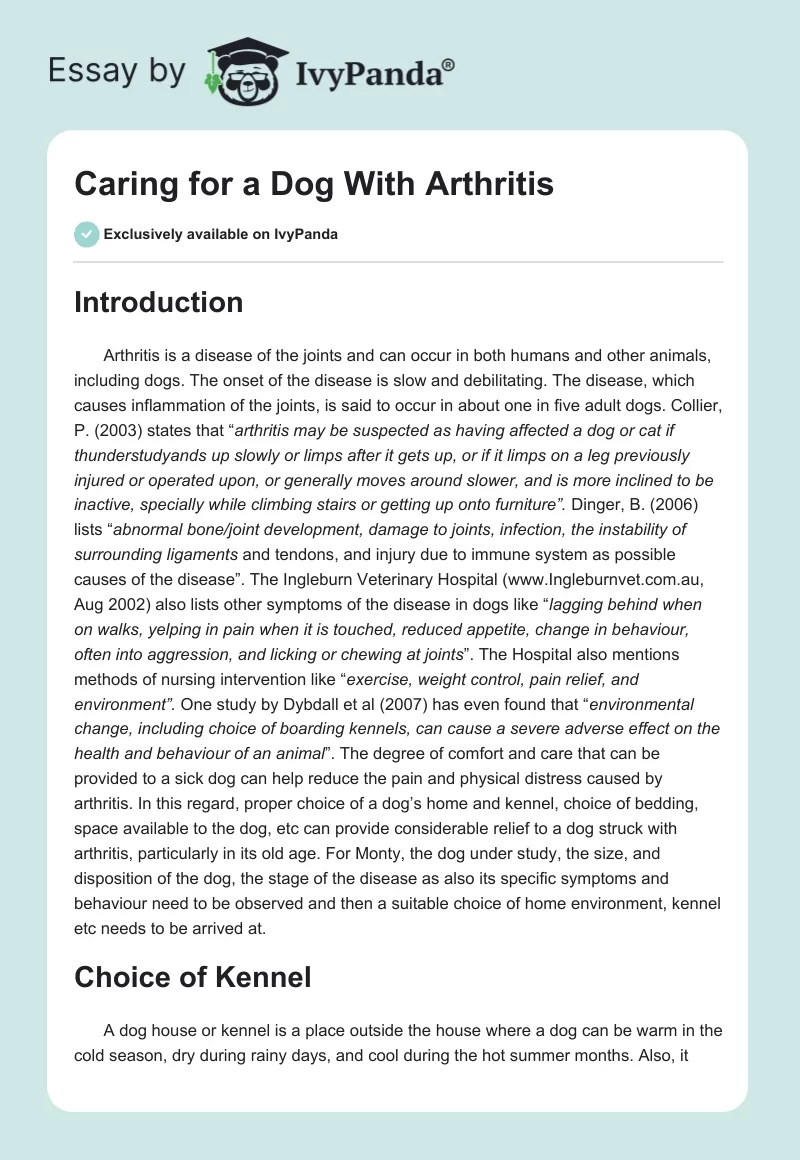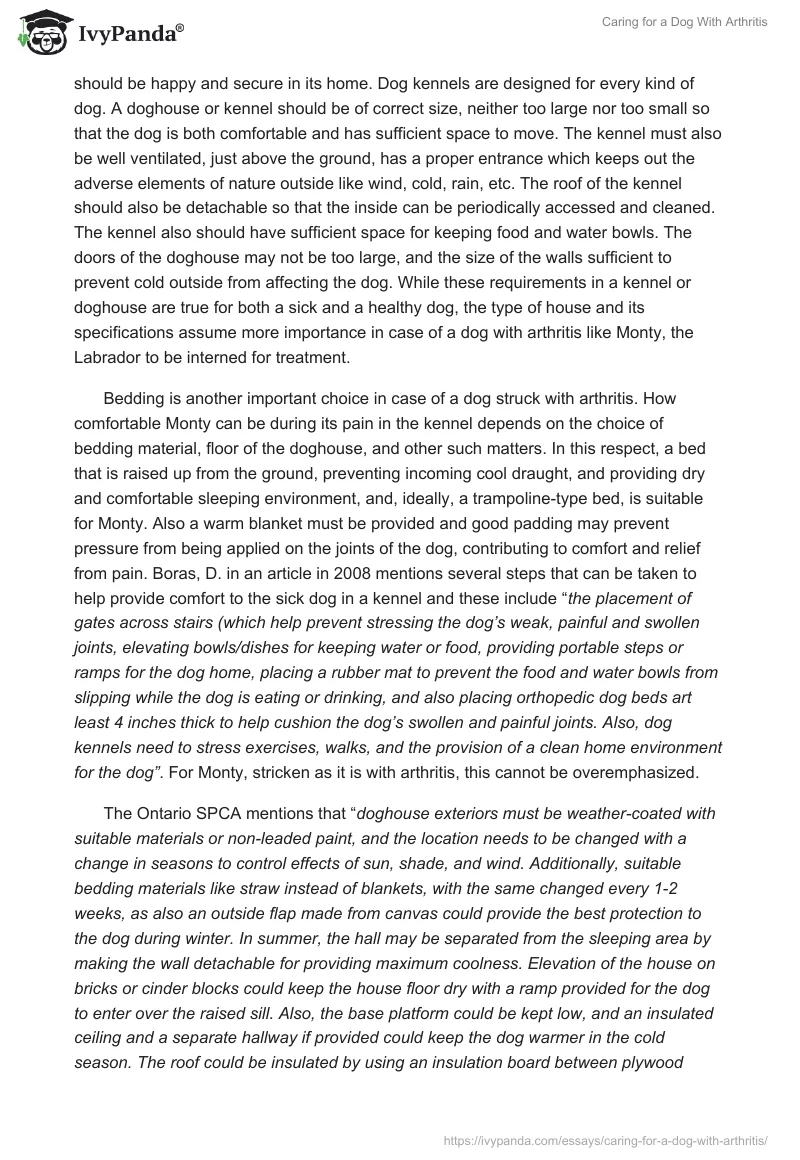Introduction
Arthritis is a disease of the joints and can occur in both humans and other animals, including dogs. The onset of the disease is slow and debilitating. The disease, which causes inflammation of the joints, is said to occur in about one in five adult dogs. Collier, P. (2003) states that “arthritis may be suspected as having affected a dog or cat if thunderstudyands up slowly or limps after it gets up, or if it limps on a leg previously injured or operated upon, or generally moves around slower, and is more inclined to be inactive, specially while climbing stairs or getting up onto furniture”. Dinger, B. (2006) lists “abnormal bone/joint development, damage to joints, infection, the instability of surrounding ligaments and tendons, and injury due to immune system as possible causes of the disease”. The Ingleburn Veterinary Hospital (www.Ingleburnvet.com.au, Aug 2002) also lists other symptoms of the disease in dogs like “lagging behind when on walks, yelping in pain when it is touched, reduced appetite, change in behaviour, often into aggression, and licking or chewing at joints”. The Hospital also mentions methods of nursing intervention like “exercise, weight control, pain relief, and environment”. One study by Dybdall et al (2007) has even found that “environmental change, including choice of boarding kennels, can cause a severe adverse effect on the health and behaviour of an animal”. The degree of comfort and care that can be provided to a sick dog can help reduce the pain and physical distress caused by arthritis. In this regard, proper choice of a dog’s home and kennel, choice of bedding, space available to the dog, etc can provide considerable relief to a dog struck with arthritis, particularly in its old age. For Monty, the dog under study, the size, and disposition of the dog, the stage of the disease as also its specific symptoms and behaviour need to be observed and then a suitable choice of home environment, kennel etc needs to be arrived at.
Choice of Kennel
A dog house or kennel is a place outside the house where a dog can be warm in the cold season, dry during rainy days, and cool during the hot summer months. Also, it should be happy and secure in its home. Dog kennels are designed for every kind of dog. A doghouse or kennel should be of correct size, neither too large nor too small so that the dog is both comfortable and has sufficient space to move. The kennel must also be well ventilated, just above the ground, has a proper entrance which keeps out the adverse elements of nature outside like wind, cold, rain, etc. The roof of the kennel should also be detachable so that the inside can be periodically accessed and cleaned. The kennel also should have sufficient space for keeping food and water bowls. The doors of the doghouse may not be too large, and the size of the walls sufficient to prevent cold outside from affecting the dog. While these requirements in a kennel or doghouse are true for both a sick and a healthy dog, the type of house and its specifications assume more importance in case of a dog with arthritis like Monty, the Labrador to be interned for treatment.
Bedding is another important choice in case of a dog struck with arthritis. How comfortable Monty can be during its pain in the kennel depends on the choice of bedding material, floor of the doghouse, and other such matters. In this respect, a bed that is raised up from the ground, preventing incoming cool draught, and providing dry and comfortable sleeping environment, and, ideally, a trampoline-type bed, is suitable for Monty. Also a warm blanket must be provided and good padding may prevent pressure from being applied on the joints of the dog, contributing to comfort and relief from pain. Boras, D. in an article in 2008 mentions several steps that can be taken to help provide comfort to the sick dog in a kennel and these include “the placement of gates across stairs (which help prevent stressing the dog’s weak, painful and swollen joints, elevating bowls/dishes for keeping water or food, providing portable steps or ramps for the dog home, placing a rubber mat to prevent the food and water bowls from slipping while the dog is eating or drinking, and also placing orthopedic dog beds art least 4 inches thick to help cushion the dog’s swollen and painful joints. Also, dog kennels need to stress exercises, walks, and the provision of a clean home environment for the dog”. For Monty, stricken as it is with arthritis, this cannot be overemphasized.
The Ontario SPCA mentions that “doghouse exteriors must be weather-coated with suitable materials or non-leaded paint, and the location needs to be changed with a change in seasons to control effects of sun, shade, and wind. Additionally, suitable bedding materials like straw instead of blankets, with the same changed every 1-2 weeks, as also an outside flap made from canvas could provide the best protection to the dog during winter. In summer, the hall may be separated from the sleeping area by making the wall detachable for providing maximum coolness. Elevation of the house on bricks or cinder blocks could keep the house floor dry with a ramp provided for the dog to enter over the raised sill. Also, the base platform could be kept low, and an insulated ceiling and a separate hallway if provided could keep the dog warmer in the cold season. The roof could be insulated by using an insulation board between plywood pieces, and a small rainproof vent could be provided which would help dissipate any moisture accumulated inside the dog house, thereby reducing the possibility of mold” (www.ospca.on.ca, 2008). The Ontario SPCA also mentions the dimensions of the dog house as 36 inches of floor space for each inch of the dog’s height, and 1 to 2 inches more than a dog’s height when measured in its sitting position to yield the height of the ceiling from the floor of the sleeping area. For a retriever like Monty, the Labrador, the following table (Table 1) would list the ideal dimensions of a kennel according to the SCPA:
Table 1. Areas and Ceiling Heights 24” (Shoulder) / 27” (Sitting) (Inside measurements)

Monty’s Nursing Care Plan
Weight Loss Program
A weight loss program aiming to decrease weight at a rate of 0.5 to 2 % of the bodyweight per week is envisaged. The diet would attempt to provide calorie deficit, maintain the levels of protein, vitamins, and minerals required for maintenance, as also achieve a gradual and safe weight loss. While adopting the weight loss program for achieving a targeted reduction in weight over some time, the dietary management would also help check the progress of arthritis, alleviate pain and other clinical symptoms, safeguard the heart from possible attacks caused by obesity complications and also safeguard against failure of secondary organs. The program would also help alleviate respiratory troubles, if any, improve tolerance of Monty to exercise, aid in countering arthritis, alleviate pain, prevent other diseases like skin disease, heart disease, and diabetes mellitus from occurring as also help prolong the dog’s life and strengthen the quality of life, particularly in the old age. Since Monty appears to crave more food even after feeding him his regular dosage, a nutrient-rich diet at regular periodicity coupled with regular waste elimination, exercises, walks, and phasing out of treats could be essential to reduce body weight, alleviate joint pain and bring him around to normal life and activity. A gradual and safe weight loss coupled with a balanced diet of protein, vitamins, and minerals is envisaged thus.
Depending on the degree of cooperation that can be achieved from the dog, a mix of regular exercise and food habits through a controlled diet regimen, Monty could be well on the road to recovery. In addition, depending on the severity of the physiological conditions, a controlled regime of exercise twice daily may be attempted to bring around the wellness of the dog. Hawkins, K. (Mar 2006) maintains that “most dogs take around ten to twelve months to achieve their target reduced weight and this depends on the actual weight that can be lost by a particular dog”. Blanchard, G has also acknowledged, like many others, that “obesity is a disease, and that its treatment is now regarded as beneficial to health and life expectancy of pets” and also further stated that the “problem is more pronounced with age, gender, and sexual status, and particularly, the Retriever breed of dogs are more vulnerable to obesity” (2008). For effecting a gradual weight reduction, exercise and regular regimen as part of a nursing schedule can be given as follows:
7.00a.m. Dog to be taken out and walked. His feces to be noted for constitution, color, quantity, and odour
7.30 a.m. Medications as prescribed by the vet to be given
8.00 a.m. Food to be given Quantity of food taken and water drunk to be noted
8.30 a.m. Grooming, bathing, if required, motion exercises, etc to be done
9.00 to 11.00 a.m. Note down specific problem issues to be given to the Vet
11.00 a.m. Take out Monty on a walk and record on eliminations
11.30 a.m. to 3.30 p.m. Monitor and record activities of the dog
3.30 p.m. to 4.30 p. m. Medications to be scheduled and Monty to be walked under
Observation
5.30 p.m. TO feed Monty, give water to drink, and record observations
6.00 p.m. to 10.00 p.m. Monitor and record observations on the dog’s activities
10.00 p.m. Take him on a supervised walk
11.00 p.m. Give Medication, before he goes to sleep
Monty would be fed 60% of the daily MER at a bodyweight set at 15% less than actual weight during the first assessment. The MER was calculated as per the formula: MER (MJ) = 06. X 0.42 x BW0.75 Once the target is arrived at, an estimation of time for achieving the same as also the diet to be planned is the next step in the program. The time required to effect the weight reduction is approximated to be around 1% per week in the case of Monty, a conservative estimate considering the present lameness of the dog. The ideal diet needs to restrict calorie intake (low in energy) and at the same time maintain satiety, and contain less fat but have more fiber. “Certain nutrients help the dog’s health and joint management which include Glucosamine and Chondroitin Sulfate, Shark Cartilage, Bovine Cartilage, Perna Canaliculus, Sea Cucumber, etc”. (pet-supplies-review.com, 2008) The body weight also needs to be weighed on a fortnightly basis and monitored to see if the program is on track. Table 2 below shows the minimum protein requirements for an adult dog (8 to 12 years old)
Table-2: Minimum Nutrient Requirements of Dogs for Growth and Maintenance (Amounts per kg body Weight per Day)
Protein
(Adapted from: Compendium of Pet Animal Practice, Dr Chander, S., 2004)
“It may be more useful to remember that an adult, non-reproducing dog requires about 22% of the diet dry matter as an average quality protein. Carbohydrates may safely supply 60% of dietary calories without causing a deficiency of proteins, fats, minerals or vitamins. Dietary fat supplies concentrated energy and essential fatty acids, and makes the diet palatable. While only 2% fat as com or soy oil (50%. linoleic acid) s needed to provide the essential unsaturated fatty acids, fat levels of 6-8% on dry matter basis are frequently added to diets for palatability and to help meet the energy requirement”.
Table-3: Minimum Nutrient Requirements of Dogs for Growth and Maintenance (Amounts per kg Body Weight per Day)
FATS
(Adapted from: Compendium of Pet Animal Practice, Dr Chander, S.,2004)
The most recent estimates of the energy requirement of dogs are given in following table 4:
ENERGY
Table-4: Caloric and daily food allowance for the maintenance of adult dogs
(Adapted from: Compendium of Pet Animal Practice, Dr Chander, S., 2004)
Dogs require at least 13 vitamins and the table below shows the ideal intake:
Table 5: Minimum Nutrient Requirements of Dogs for Growth and Maintenance
(Amounts per kg Body Weight per Day)
(Adapted from: Compendium of Pet Animal Practice, Dr Chander, S., 2004)
Table-6: Minimum Nutrient Requirements of Dogs for Growth and Maintenance (Amount per kg body weight per day)
Table-7: Examples of semisolid foods for dogs (%)
(Adapted from: Compendium of Pet Animal Practice, Dr Chander, S.,2004)
Conclusion
One study by Mlacknik, E. et al notes in the JAVMA (Dec 20060 that “The negative impact of obesity on health is well documented. In addition to an association with various medical disorders such as compromised immune function, abnormal glucose tolerance, acute pancreatitis, greater risk for anesthetic and surgical complications, heat and exercise intolerance, and cardiovascular disease, obesity in dogs is thought to be a risk factor for the development and progression of osteoarthritis. In humans, a correlation between osteoarthritis and obesity has already been detected; however, the exact role in dogs has not been fully investigated. The theory pertaining to the pathogenesis of osteoarthritis is that excessive body weight causes additional mechanical stress on joints, thus promoting their degeneration. Treatment of obesity is based on a restriction of caloric intake. Restricting calories to 60% of the calculated maintenance energy requirements for a dog’s target body weight has been recommended. Restriction of caloric intake and maintenance of lean body condition cannot only increase median life span but can also prevent the manifestation of chronic diseases such as osteoarthritis. In overweight dogs, osteoarthritis changes appear earlier in life and are more severe, compared with their restricted-fed siblings”.


